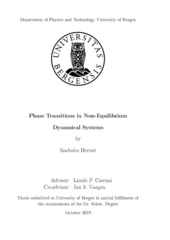Phase transitions in non-equilibrium dynamical systems
Doctoral thesis
Permanent lenke
https://hdl.handle.net/1956/4729Utgivelsesdato
2010-12-09Metadata
Vis full innførselSamlinger
Sammendrag
This work is a summary of three papers (references [5, 14, 24]), which deal with modelling the hadronization and freeze-out in heavy ion collisions. There is evidence that this is a non-equilibrium process, and therefore cannot be described in a quasi-statical way, assuming local phase equilibrium. The study of dynamical phase transitions is an important subject, as it has practical applications not only in the description of nuclear collisions, but also in many other fields, e.g. in technical applications which involve high temperature detonations. Examples include gas turbines, internal combustion engines, rocket engines, etc. The correct description of some of these processes requires a relativistic approach. For example, in a rocket engine, radiation pressure has an important role in stabilizing the detonation front, therefore a relativistic description is required despite the relatively small flow velocities. Lessons learned from the study of the dynamical phase transition in heavy ion collisions can be applied to these other fields as well. The first part of the work, based on [5, 14], analyses the final stages of expansion in fluid dynamical models, taking into account the effects of numerical viscosity in computational approaches. A way to compute the thermodynamic parameters, such as temperature and entropy, is presented. These parameters are relevant for finding the location of the freeze-out surface. The second part of the work, based on [24], presents a simple model of rapid and dynamical hadronization that is capable of reproducing the constituent quark number scaling of elliptic flow, as observed in experiments.
Utgiver
The University of BergenOpphavsrett
The authorCopyright the author. All rights reserved
